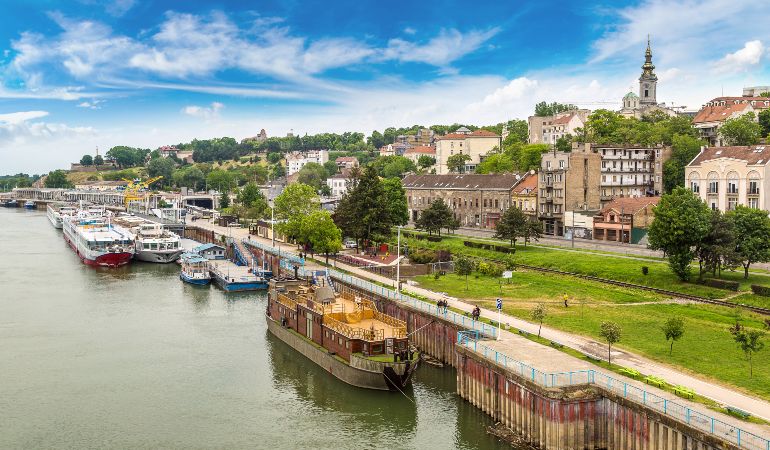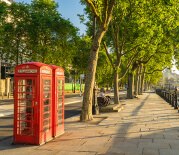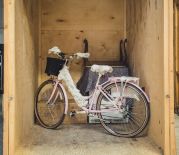
In this guide, you’ll find information on health, education, benefits, residence requirements, and more, which are essential for British nationals moving to Serbia from the UK.
Serbia can be an exciting adventure filled with new experiences and opportunities for those moving from the UK. Whether you’re moving for work, study, or personal reasons, you need to understand the intricacies.
Table of Contents
Can Brits live in Serbia?
A D visa (long-stay visa) is required if you intend to stay in Serbia for 90 days or more within six months. You should apply for a D visa before your intended trip to Serbia if you plan on applying for a residence permit there.
Geographical information
Serbia, located in the heart of Southeast Europe, offers a diverse landscape ranging from fertile plains in the north to mountainous regions in the south. The climate is continental, with hot summers and cold winters, making spring and autumn the most pleasant times to visit or move.
Capital City: Belgrade
Population: 6.945 million
Official language: Serbian
Commonly spoken languages: Hungarian, Romanian, Slovak, Rusyn, Croatian, Bosnian, Romani, Albanian, Vlach, Bulgarian, Macedonian, Montenegrin and Bunjevac
Currency: Serbian dinar – Here is more information about the cost of living in Serbia
Exchange rate to pound: 1: 0.0073
As for water bodies, the Danube runs through the country and is the longest river in Serbia. Serbia also has five national parks, and its highest point is 2,169 metres, while the lowest is 35 metres. The country has a 30% landmass of forests, making it a great place if you’d like to spend time outdoors.
Where to live in Serbia
Although the capital, Belgrade and Novi Sad, are the two largest cities, other smaller towns have real charm and are a delight to visit and they are one of the best places to live in Serbia, if that’s your inclination. Here are some of them:
- Sremski Karlovci
It’s situated approximately eight kilometres from Novi Sad and was previously the seat of the Serbian Orthodox Church in the Habsburg Monarchy. It is well-known for its “elegant and varied architecture” and the overall atmosphere of the town is sleepy with just enough bustle to keep things interesting.
- Sirogojno
A village in Zlatibor, it is made up of an open-air museum, showcasing traditional ways of life from the region, dating back to the 19th century. It is known for its wooden buildings and was declared a Cultural Monument of Exceptional Importance in 1983.
- Knjaževac
Situated between three different mountains and a place where the Timok River passes through, Knjaževac has small colourful houses as it also has a lovely city centre.
- Drvengrad
Also known as Küstendorf, this village was specifically constructed for Emir Kusturica’s classic Life Is A Miracle.
- Rajski Konaci
This place is full of vibrant buildings and lush greenery.
Mokra Gora: best known for its narrow-gauge railway. - Topola
Known for its historical significance and St George’s Church, which is colloquially known as Oplenac. It has an incredible interior mosaic made of around 40 million coloured pieces.
- Palić
Situated just a few kilometres from the Hungarian border, it has a Hungarian ethnic majority population, and has the thousand-year-old Lake Palić nearby.
- Donja Lokošnica
It’s known for its celebration of the red pepper in autumn, where everything turns red for a couple of weeks illuminated in beauty.
- Latkovac
Known as an ethno-village, it is around 500 years old. It consists of four traditional houses made of straw, mud and beams.
- Prijepolje
This town lies on the confluence of the Lim and Mileševka rivers and is surrounded by forests. It also has a few lovely riverside beaches. You can also enjoy the Mileševa monastery.
- Perućac
Located on the right bank of the Drina River, Perućac is close to Tara National Park and Lake Perućac.
How to become a resident of Serbia
UK citizens need a valid passport to enter Serbia and can stay for up to 90 days without a visa. For longer stays, you will need to apply for a temporary residence permit. Work permits are also necessary if you plan to take up employment, and registration with local authorities is mandatory within 24 hours of arrival.
If you’d like to request to become a permanent resident of Serbia, your request needs to be submitted in writing to the Police Directorate for the City of Belgrade in Belgrade. There are three ways in which you can become a permanent resident.
- An individual who has continuously resided in Serbia for longer than five years.
- A foreign citizen who was authorised temporary stay in the country for the purpose of employment or education.
- Marriage to a Serbian citizen.
The documents you will be required to submit will depend on your case above and may include the following:
- A completed application form
- Proof of paid fees
- A photocopy of your passport
- Two photographs
- A medical certificate
- Certificate or other educational documents
- Birth certificate
- A certificate of employment with information regarding your salary
- Proof of accommodation
- Proof of kinship with a Serbian citizen
Working in Serbia
The Serbian economy is a service-based, upper-middle-income economy. The tertiary sector accounts for two-thirds of the total GDP. Some of the jobs with the highest demand include those of sales personnel, couriers/delivery workers and call centre, workers.
In 2020, the most sought-after industries related to work demand were: trade, sales, computer science, mechanical engineering, administration and electrical engineering, warehousing, construction, transportation, and call centres.
There is a great demand for IT staff, particularly in middle management. The most sought-after positions in IT were JavaScript developer, Java developer, IT help desk, Net developer and PHP developer.
The labour market in Serbia is considered to have many staff shortages, particularly in the professions of hairdressers, cooks, car mechanics, carpenters, and warehouse workers.
Transportation in Serbia
If you’re travelling in Serbia, transportation there includes transport by road, rail, water and air.
Regarding the road network, it is considered of relatively poor standards compared to Western European countries due to limited maintenance over the last 20 years.
However, the country’s road transport infrastructure network is extensive and transported approximately 55.8 million passengers by bus in 2018. The bus infrastructure network is extensive and enables you to reach large towns and smaller villages. Domestic and international routes are served by more than 100 intercity coach services, the biggest of which are Lasta and Niš-Ekspres.
Driving your car in Serbia
To drive from the UK to Serbia, you will need a UK driving licence or International Driving Permit on short visits for up to a year from the date of first entry. Alternatively, your license must be for a single stay of up to six months. For visits longer than six months, you will be required to obtain a local licence.
Serbian authorities generally retain UK driving licences when you apply for a Serbian driving licence. These licenses are sent by the Serbian Ministry of Interior to the British Embassy, which in turn, is required to return them to the DVLA in the UK. An International Driving Permit cannot be exchanged for a Serbian licence.
For those considering bringing a vehicle into Serbia, you must have vehicle registration and ownership documents and a locally valid insurance policy.
Education in Serbia
The Serbian education system includes preschool, primary, secondary and higher education, with the complete duration of compulsory education being 9 years. Children start their compulsory education at the age of 5½ at the preschool preparatory programme, followed by 8 years of primary education.
Being a student in Serbia
The Serbian higher education system offers two types of studies:
- Academic studies organised at universities, or
- Applied studies organised at colleges of applied studies or at universities
In 2003, the country underwent reforms of its higher education system when it joined the Bologna Process. It also passed a new law on higher education, which introduced the European Credit Transfer System, a three-cycle study system, and a diploma supplement.
As of 2007/2008, all newly-enrolled students now study under the new reformed programmes at all higher education institutions.
The Serbian university studies system offers:
- Bachelor and undergraduate studies
- Master and specialised studies
- PhD studies
Meanwhile, vocational studies comprise two levels:
- Colleges of Applied Studies
- Specialised Colleges of Applied Studies
Healthcare in Serbia
The healthcare system in Serbia is managed by the National Health Insurance Fund (RFZO). It covers all citizens and permanent residents. Contributions to it are paid for by all workers, self-employed individuals and pensioners. Contributions are based on a sliding scale, with those earning higher income required to make higher contributions.
The healthcare system in the country is known for its corruption, where citizens usually pay bribes to receive treatment. There has been a strong movement to tackle this challenge by both the government and NGOs.
Moving to another country? Count on Fantastic Removals for an easy relocation!
Enter your postcode to view our rates and availability in your area.
For questions about the services we offer visit our main site or you can always call us at 020 3746 0584
Takeaways
Moving from the UK to Serbia can be a rewarding experience filled with new adventures and cultural insights. By understanding the local customs, exploring the must-visit attractions, and preparing adequately for the move, you can ensure a smooth transition and a fulfilling life in your new home.
Embrace the opportunity to immerse yourself in Serbian culture, make new friends, and explore the beautiful landscapes that this country has to offer.














